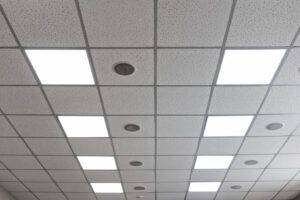Installing a suspended ceiling is an excellent way of transforming a space, especially one with high ceilings. It can significantly impact the look and feel of an area and help create a much more comfortable work environment for employees.
There are also practical benefits to installing a suspended ceiling, which may have you considering installing one in your workplace. Creating an inspiring workplace can help boost productivity and employee well-being; a suspended ceiling can help you achieve this. Below, you can see why suspended or dropped ceilings are an excellent choice and a guide to installing them.
Why Choose A Suspended Ceiling?
Before delving into the installation process of suspended ceilings, we will quickly examine what makes them so good and the benefits they provide. Below, you can see what makes suspended ceilings better than traditional drywall or plaster ceilings to help you decide if they are the best option for your workplace.
Aesthetic Appeal – Dropped ceilings can help improve the aesthetics in your workplace, and they are available in various styles and designs. They can hide imperfections in the original ceiling, and cables and ducting, and give your office a clean and modern look.
Easy Access – If you place utilities such as cabling or air ducts behind your suspended ceiling, you can easily access them for repairs or maintenance by removing the ceiling tiles.
Acoustic Benefits – You can also help control noise better in your office by reducing the ceiling height and the echo and installing sound-absorbing ceiling tiles. It is an excellent option in environments where noise can be an issue, such as bust call centres.
Insulation – You can also increase the energy efficiency of your office by adding insulation behind your suspended ceiling if there is room. It can help reduce energy bills and make your office space a more comfortable temperature throughout the year.
Now that you know some of the benefits of installing this type of ceiling in your office, here is a quick suspended ceiling installation guide to help you see what work is involved.
Materials, Tools & Equipment
There are various tools and materials you will need to complete the task of installing a suspended ceiling, and here is a list of everything required:
Materials:
Ceiling Tiles – Various styles and designs are available.
Suspended Grid System – Comprising wall angles, runners, and cross tees.
Wire Hangers – For suspending the grid from the ceiling.
Eye Hooks – To Attach wires to the ceiling.
Screws & Anchors – For securing the grid components together.
Ceiling Tile Adhesive – This is not compulsory but is recommended for stability.
Drop Ceiling Edge Trim – Giving a finished look around the perimeter of the ceiling.
Insulation – You will also need insulation if you want to add this to your dropped ceiling.
Tools & Equipment
Ladders
Tape Measure
Chalk Line
Spirit Level
Utility Knife
Cordless Drill
Screwdriver
Tin Snips
Safety Equipment
Once you have assembled everything you need, you can start installing your suspended ceiling in your workplace and here are some basic instructions.
An Easy Installation Guide
Here are the basic steps you must take to install your suspended ceiling. Take your time and do not rush the task; if you get stuck, you can find plenty of tutorial videos online to help.
Measure & Plan
You will need to measure the room and determine the number of ceiling tiles and grid components you will need. Plan the layout of the grid so it is symmetrical and level and has the aesthetics you want for your space.
Create A Reference Line
You can now use the chalk line to create a reference line along the current ceiling, which will act as a guide for installing the runners of the grid. Once you are happy your reference line is true and in the correct position, you can move onto the next step.
Install Wall Angles
Attach the wall angles to the perimeter of the room using the screws and anchors, and you must ensure they are securely fastened. These points will be weight bearing which is why they must be secure and will not move.
Hang The Wires
You can now use the eye hooks to attach the wire hangers at regular intervals, and ensure they are securely anchored to the ceiling. The wires will support the grid as it hangs, so it is better to have too many hooks than not enough.
Install The Main Runners
Hang the main runners along the reference line you made earlier, connect them to the wall angles and secure them to the wire hangers. Ensure you use your spirit level to ensure they are straight and level.
Add The Cross Tees
Insert the cross tees along the main runner at appropriate intervals, which will make the grid you will use for the ceiling tiles. Ensure you seat the cross tees securely in the slots on the runner to keep them help firmly in place.
Install The Ceiling Tiles
You can now start installing the ceiling tiles in your suspended ceiling, and you may need to cut some tiles to make the fit, which you can do easily using a utility knife. Ensure the tiles fit snugly in the grid, and you can use the ceiling tile adhesive to ensure each tile is secure.
Add The Ceiling Edge Trim
When you install the edge trim to your drop ceiling it will create a clean and finished appearance for the ceiling in your space.
Insulation
Adding insulation is optional for your ceiling, and it depends if you will be hiding cabling or ducting in the cavity. However, if you have the space, you can add extra insulation to give you better energy-efficiency and soundproofing for your building.
The Finishing Touches
You will now want to inspect your suspended ceiling closely and ensure that everything is firmly in place. You may also need to adjust the ceiling to ensure everything is sitting level and straight.
Hopefully this guide has shown you the process of installing a suspended ceiling so you can understand it better. It only takes basic DIY skills so you can consider doing the work yourself, or you can hire an experienced company to complete the task in a fraction of the time. Once complete, your office space will look fantastic and you can enjoy the benefits of better aesthetics, and increased thermal and acoustic insulation, making for a comfortable workspace.
Read more:
An informative guide on installing a dropped ceiling in your property
















